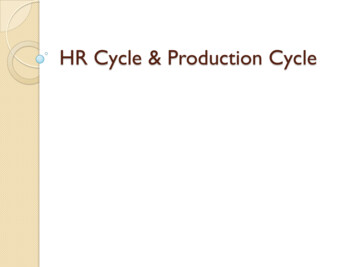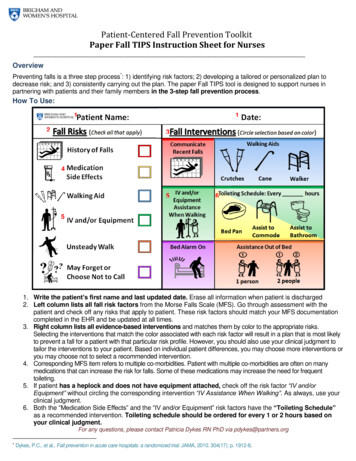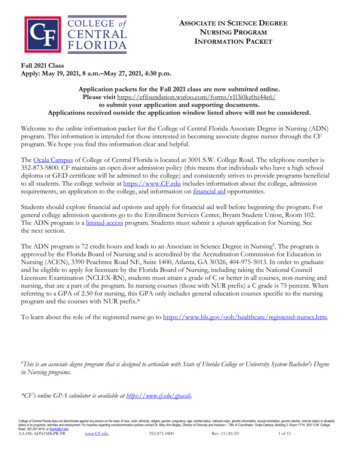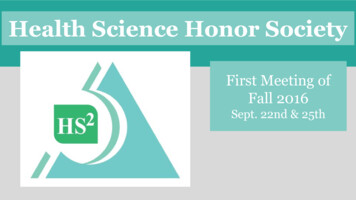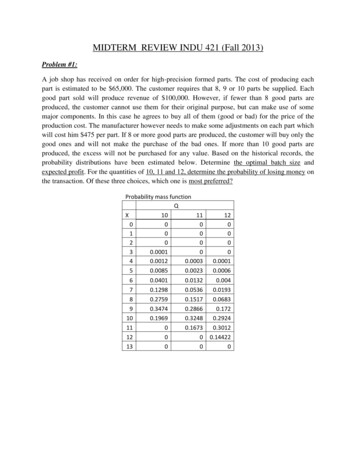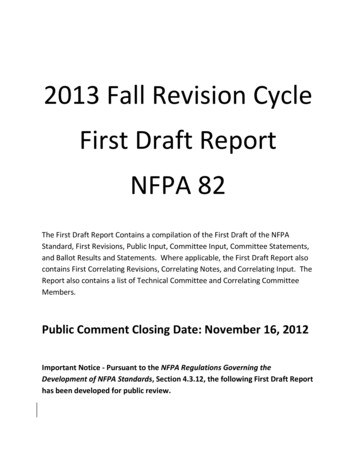
Transcription
2013 Fall Revision CycleFirst Draft ReportNFPA 82The First Draft Report Contains a compilation of the First Draft of the NFPAStandard, First Revisions, Public Input, Committee Input, Committee Statements,and Ballot Results and Statements. Where applicable, the First Draft Report alsocontains First Correlating Revisions, Correlating Notes, and Correlating Input. TheReport also contains a list of Technical Committee and Correlating CommitteeMembers.Public Comment Closing Date: November 16, 2012Important Notice - Pursuant to the NFPA Regulations Governing theDevelopment of NFPA Standards, Section 4.3.12, the following First Draft Reporthas been developed for public review.
Pursuant to the NFPA Regulations Governing the Development of NFPA Standards, Section 4.3.12, thefollowing First Draft Report has been developed for public review.Please note that the following First Draft Report represents an interim step in the implementation of thenew NFPA Standards Process and will ultimately be replaced by the NFPA Standards Development Sitewhich will provide a much more robust and interactive First Draft Report. This interim solution isprovided to ensure that reviewers of the First Draft Documents for the Fall 2013 revision cycle areprovided with a single report contacting all of the relevant materials addressed in the proposed FirstDraft NFPA Standard and to provide the required information to the user for their preparation forsubmission of Public Comments on the First Draft of the NFPA Standard.The First Draft Report is a consolidated report of the following individual items:1. First Draft – The First Draft of the NFPA Standard represents a “track changes” view of theproposed First Draft for public review. The First Draft contains all of the proposed changes tothe NFPA Standard by the Technical Committee2. First Revision Cross Reference – This document provides a cross reference between the FirstRevisions and the related Public Inputs as identified by the Technical Committee. This reportwill help a user to quickly identify what related Public Inputs should be review to get a completeunderstanding of the proposed changes by the Technical Committee.3. First Revision Report – This report contains of all of the First Revisions that have passedTechnical Committee letter ballot and which have been incorporated in to the First Draft. TheFirst Revisions have been organized in document order and are identified by the [FR #:FileMaker] number.4. Public Input Report – This report contains all of the submitted Public Input organized indocument order. Each Public Input contains the submitter information, recommendation, andthe Committee response to the Public Input.5. Ballot Results Report - This report contains the individual ballot results on each First Revisionand has been organized in First Revision order, by the [FR #: FileMaker] number. Additionally,where applicable the ballot results also contain any associated Ballot Statements by TechnicalCommittee Members.6. Additional Reports – Where applicable reports of Committee Input, Correlating First Revisions,and Correlating Notes have been included and organized in document order. Where thesereports are not included in the First Draft Report the document contained no Committee Input,Correlating First Revisions or Correlating Notes.If after your review of the First Draft and related First Draft Report you wish to submit Public Commentson the First Draft of the NFPA Standard please go to - www.nfpa.org/XXnext - (for example for NFPA 82– www.nfpa.org.82next) and click on the link to “Submit Public Comment Online” (Also, for furtherinstructions refer to Annex A in the back of the First Draft Report).Please note that the deadline for submitting Public Comments is November 16, 2012.
How to use this First Draft ReportThe First Draft Report is provided to the give the user a single document containing all of the relatedmaterials associated with the Technical Committee development of the First Draft of the NFPA Standard.The intent of the First Draft Report is to provide the public with a document that allows review andwhere applicable preparation of material for submission as Public Comments on the text of the FirstDraft.The user should initially review the First Draft of the NFPA Standard to determine if the proposedchanges (First Revisions) by the technical committee are acceptable. Where the user identifies areas ofthe document which require additional changes to address their concerns the user should then reviewthe related First Revisions, Public Inputs, and where applicable Committee Inputs, First CorrelatingRevisions or Correlating Notes to determine if their concerns have been addressed. These reports havebeen organized in document (section) order to allow the user to review all related material for a givensection of the NFPA standard. To assist in the user review a First Revision Cross Reference has beenprovided which details the Public Inputs that are directly related to a given First Revision.Additionally, where the user wishes to review all technical issues and concepts proposed through PublicInput, regardless of the incorporation into First Revisions, the user should review the Public InputReport, which is organized in document order to facilitate review.If during the review of the First Draft and First Draft Report material the user determines that additionalchanges need to be made to the First Draft of the NFPA Standard the user should then proceed to theNext Edition Tab of the appropriate Document Information Page to submit Public Comments on the FirstDraft. All submitted Public Comments will then be considered by the Technical Committee at theirComment Meeting.It is important to note that in accordance with the Regulations Governing the Development of NFPAStandards, Section 4.4.4, all Public Comments shall be limited to proposing revisions the First Draft ofthe NFPA Standard.If during the review of the First Draft Report or during the submission of Public Comments the user hasany questions please contact us at 617-984-7240 or via email at - standardsdev support@nfpa.org.
Information on the NFPA Standards Development ProcessI. Applicable Regulations. The primary rules governing the processing of NFPA standards (codes, standards, recommendedpractices, and guides) are the NFPA Regulations Governing the Development of NFPA Standards (Regs). Other applicable rulesinclude NFPA Bylaws, NFPA Technical Meeting Convention Rules, NFPA Guide for the Conduct of Participants in the NFPAStandards Development Process, and the NFPA Regulations Governing Petitions to the Board of Directors from Decisions of theStandards Council. Most of these rules and regulations are contained in the NFPA Standards Directory. For copies of theDirectory, contact Codes and Standards Administration at NFPA Headquarters; all these documents are also available on theNFPA website at “www.nfpa.org.”The following is general information on the NFPA process. All participants, however, should refer to the actual rules andregulations for a full understanding of this process and for the criteria that govern participation.II. Technical Committee Report. The Technical Committee Report is defined as “the Report of the responsible Committee(s), inaccordance with the Regulations, in preparation of a new or revised NFPA Standard.” The Technical Committee Report is in twoparts and consists of the First Draft Report and the Second Draft Report. (See Regs at 1.4)III. Step 1: First Draft Report. The First Draft Report is defined as “Part one of the Technical Committee Report, whichdocuments the Input Stage.” The First Draft Report consists of the First Draft, Public Input, Committee Input, Committee andCorrelating Committee Statements, Correlating Input, Correlating Notes, and Ballot Statements. (See Regs at 4.2.5.2 andSection 4.3) Any objection to an action in the First Draft Report must be raised through the filing of an appropriate Comment forconsideration in the Second Draft Report or the objection will be considered resolved. [See Regs at 4.3.1(b)]IV. Step 2: Second Draft Report. The Second Draft Report is defined as “Part two of the Technical Committee Report, whichdocuments the Comment Stage." The Second Draft Report consists of the Second Draft, Public Comments with correspondingCommittee Actions and Committee Statements, Correlating Notes and their respective Committee Statements, CommitteeComments, Correlating Revisions, and Ballot Statements. (See Regs at Section 4.2.5.2 and 4.4) The First Draft Report and theSecond Draft Report together constitute the Technical Committee Report. Any outstanding objection following the Second DraftReport must be raised through an appropriate Amending Motion at the Association Technical Meeting or the objection will beconsidered resolved. [See Regs at 4.4.1(b)]V. Step 3a: Action at Association Technical Meeting. Following the publication of the Second Draft Report, there is a periodduring which those wishing to make proper Amending Motions on the Technical Committee Reports must signal their intentionby submitting a Notice of Intent to Make a Motion. (See Regs at 4.5.2) Standards that receive notice of proper AmendingMotions (Certified Amending Motions) will be presented for action at the annual June Association Technical Meeting. At themeeting, the NFPA membership can consider and act on these Certified Amending Motions as well as Follow-up AmendingMotions, that is, motions that become necessary as a result of a previous successful Amending Motion. (See 4.5.3.2 through4.5.3.6 and Table1, Columns 1-3 of Regs for a summary of the available Amending Motions and who may make them.) Anyoutstanding objection following action at an Association Technical Meeting (and any further Technical Committee considerationfollowing successful Amending Motions, see Regs at 4.5.3.7 through 4.6.5.3) must be raised through an appeal to the StandardsCouncil or it will be considered to be resolved.VI. Step 3b: Documents Forwarded Directly to the Council. Where no Notice of Intent to Make a Motion (NITMAM) isreceived and certified in accordance with the Technical Meeting Convention Rules, the standard is forwarded directly to theStandards Council for action on issuance. Objections are deemed to be resolved for these documents. (See Regs at 4.5.2.5)VII. Step 4a: Council Appeals. Anyone can appeal to the Standards Council concerning procedural or substantive mattersrelated to the development, content, or issuance of any document of the Association or on matters within the purview of theauthority of the Council, as established by the Bylaws and as determined by the Board of Directors. Such appeals must be inwritten form and filed with the Secretary of the Standards Council (See Regs at 1.6). Time constraints for filing an appeal mustbe in accordance with 1.6.2 of the Regs. Objections are deemed to be resolved if not pursued at this level.VIII. Step 4b: Document Issuance. The Standards Council is the issuer of all documents (see Article 8 of Bylaws). The Councilacts on the issuance of a document presented for action at an Association Technical Meeting within 75 days from the date of therecommendation from the Association Technical Meeting, unless this period is extended by the Council (See Regs at 4.7.2). Fordocuments forwarded directly to the Standards Council, the Council acts on the issuance of the document at its next scheduled
meeting, or at such other meeting as the Council may determine (See Regs at 4.5.2.5 and 4.7.4).IX. Petitions to the Board of Directors. The Standards Council has been delegated the responsibility for the administration ofthe codes and standards development process and the issuance of documents. However, where extraordinary circumstancesrequiring the intervention of the Board of Directors exist, the Board of Directors may take any action necessary to fulfill itsobligations to preserve the integrity of the codes and standards development process and to protect the interests of theAssociation. The rules for petitioning the Board of Directors can be found in the Regulations Governing Petitions to the Board ofDirectors from Decisions of the Standards Council and in 1.7 of the Regs.X. For More Information. The program for the Association Technical Meeting (as well as the NFPA website as informationbecomes available) should be consulted for the date on which each report scheduled for consideration at the meeting will bepresented. For copies of the First Draft Report and Second Draft Report as well as more information on NFPA rules and for upto-date information on schedules and deadlines for processing NFPA documents, check the NFPA website(www.nfpa.org/aboutthecodes) or contact NFPA Codes & Standards Administration at (617) 984-7246.
Report of the Committee onIncinerators and Waste Handling Systems [ICN-AAA]Brian N. Polk, ChairNorth Carolina Division of Waste Management, NC [E*]Chad E. Beebe, ASHE - AHA, WA [U*]Michael F. Bracken, Wilkinson Hi-Rise, LLC, FL [M*]Sharon S. Gilyeat, Koffel Associates, Inc., MD [SE*]Christopher R. Schulz, Van-Packer Company, Inc., IL [M*]Neil P. Wu, Exponent, Inc., MD [SE*]AlternateJennifer L. Frecker, Koffel Associates, Inc., MD [SE*](Alt. to Sharon S. Gilyeat)Staff Liaison: Derek DuvalThis list represents the membership at the time the Committee was balloted on the text of this edition. Sincethat time, changes in the membership may have occurred.* A key to classifications is found in Annex A of this document.Committee Scope: This Committee shall have primary responsibility for documents on the fire-safeinstallation, inspection, maintenance, and use of incinerators, compactors, converters, other waste handlingsystems and laundry (linen) handling systems.
Copyright National Fire Protection Association 2013. All rights reserved.This copy is solely for your personal, noncommercial use in connectionwith participation in the NFPA Standards Development Process
16.11.2012 · NFPA 82 . The First Draft Report Contains a compilation of the First Draft of the NFPA Standard, First Revisions, Public Input, Committee Input, Committee Statements, and Ballot Results and Statements. Where applicable, the First Draft Report also contains First Correlating Revisions, Correlating Notes, and Correlating Input. The Report also contains a list of Technical Committee and .File Size: 2MBPage Count: 83
![First Revision No. 147-NFPA 20-2013 [ Global Input ]](/img/4/20-a15-fim-aaa-fd-frstatements.jpg)
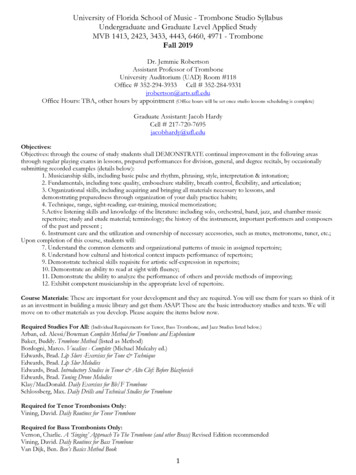
![First Revision No. 2-NFPA 33-2016 [ Section No. 1.3 ]](/img/4/33-f2017-faa-aaa-frreport.jpg)
![First Revision No. 3-NFPA 497-2014 [ Chapter 2 ]](/img/5/497-a2016-eec-aaa-fd-frstatments.jpg)

